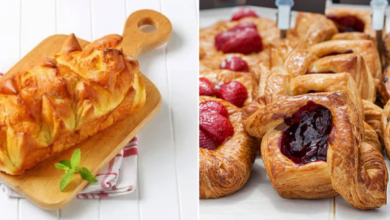The Ultimate Guide To Knowing When Brioche Is Done
What To Know
- The crust of a well-baked brioche should be a deep golden-brown color.
- If the brioche is underbaked, return it to the oven for a few more minutes.
- By using the methods outlined in this guide, you can consistently achieve perfectly baked brioche with a golden-brown crust, a soft and springy crumb, and an irresistible aroma.
Baking the perfect brioche is an art form that requires precision and attention to detail. One of the most crucial aspects of achieving a delectable brioche is knowing when it’s done baking. Overbaking can result in a dry and crumbly texture, while underbaking can leave the doughy center uncooked. This guide will provide you with comprehensive methods to determine when your brioche has reached its optimal readiness.
Visual Cues
- Golden-Brown Crust: The crust of a well-baked brioche should be a deep golden-brown color. Avoid over-browning, as this can indicate a burnt exterior.
- Matte Finish: The surface of the brioche should have a matte finish. A glossy or wet appearance suggests that the bread needs more baking time.
Auditory Cues
- Hollow Sound: Tap the bottom of the brioche. A hollow sound indicates that the interior is fully cooked.
- No Sizzling: When you insert a toothpick into the center of the brioche, there should be no sizzling sound. Sizzling indicates that the dough is still moist and needs further baking.
Sensory Cues
- Springy Texture: Gently press the brioche. It should spring back quickly, indicating a properly baked crumb.
- Firm Crust: The crust should be firm to the touch but not hard. A soft or crumbly crust suggests underbaking.
Internal Temperature
- 190-200°F (88-93°C): Use an instant-read thermometer to measure the internal temperature of the brioche. When it reaches 190-200°F, it’s done.
Other Considerations
- Size: Brioche loaves will rise significantly during baking. Allow for at least double the original size before checking for doneness.
- Oven Temperature: Calibrate your oven regularly to ensure accurate temperature readings.
- Baking Technique: Different baking methods, such as steam baking, can affect the cooking time. Adjust accordingly.
Troubleshooting Tips
- Underbaked: If the brioche is underbaked, return it to the oven for a few more minutes. Check for doneness regularly.
- Overbaked: If the brioche is overbaked, the only solution is to start over. Avoid baking at too high a temperature or for too long.
- Dense Center: Ensure that the dough was kneaded thoroughly and proofed properly before baking.
- Burnt Crust: Cover the brioche with aluminum foil during the last few minutes of baking to prevent burning.
The Verdict: Brioche Perfection
Knowing when brioche is done is a skill that comes with practice. By using the methods outlined in this guide, you can consistently achieve perfectly baked brioche with a golden-brown crust, a soft and springy crumb, and an irresistible aroma.
Questions You May Have
Q: Why is my brioche dough sticky after rising?
A: The dough may have been over-kneaded or not proofed long enough. Ensure proper kneading technique and proof the dough until it has doubled in size.
Q: Can I underbake brioche and finish baking it later?
A: No, underbaked brioche should not be reheated in the oven. It will result in an unevenly cooked and potentially unsafe loaf.
Q: How do I store leftover brioche?
A: Wrap leftover brioche tightly in plastic wrap and store it at room temperature for up to 3 days. For longer storage, freeze it for up to 2 months.
